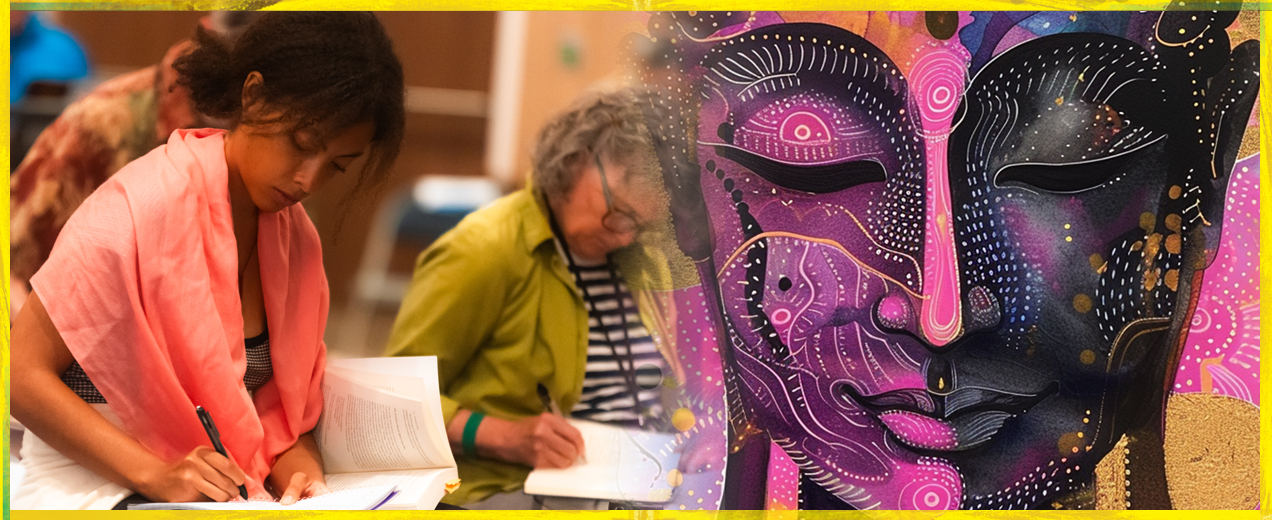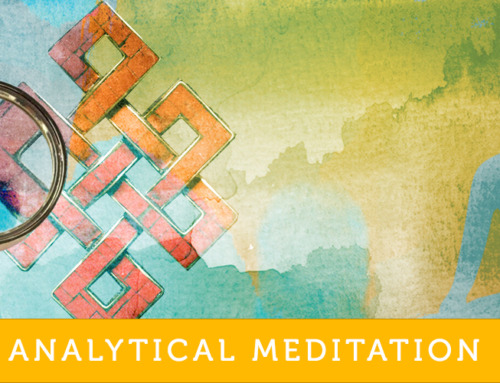The Elegance of Union:
Joining Study and Mahamudra
At Nitartha’s Summer Institute study and Mahamudra meditation are joined. Why?
Jirka Hladiš says, “It’s very simple — that’s the elegance of it. The whole point of studying the view is to clarify the object of meditation. When you get the object of meditation right, then you just rest one-pointedly on the object, without the need for more instruction.”
Study is quite extensive at Nitartha because it is crucial for determining the object of meditation. We often determine our object of meditation in an incorrect or unclear way. This creates a problem. While we still benefit from shamatha because it settles our minds, we gain nothing from practicing vipashyana when we are mistaken about the object of meditation. For example, if we meditate on emptiness with the wrong idea about what emptiness is then the vipashyana aspect of meditation is of no use.
Traditionally, in Mahamudra the skillful means, or upaya, is devotion. In the scholar/practitioner tradition of Nitartha Institute gaining certainty in the view is also upaya. We work with objects such as selflessness, emptiness, buddha nature and the nature of mind. This approach has an advantage over using devotion alone as a means: it is more stable. Since devotion is an emotion it can change from day to day, year to year or even moment to moment. But the certainty that we gain through study is unshakeable over time.
At the Summer Institute, we generally work on clarifying our object of meditation through study during the morning Buddhist philosophy courses and then in the afternoon in Mahamudra sessions we focus on that object of meditation. Making connections between the study of the view and meditation in this way is very helpful, and our shedra and Mahamudra teachers often make references that enable students to do that.
Level 1: Mahamudra Shamatha and Mind and Its World I and II
The main focus of study and practice on Level 1 is to bring about an experience of non-conceptuality of mind.
Mind and Its World I and II train us in the pramana view, known as valid cognition. This view takes us on a journey of mind from non-valid cognition to inferential valid cognition and then through the four direct valid cognitions. It leads us to identify the mistaken concepts that we hold and then to understand increasingly more subtle degrees of valid concepts, and then to the idea of non-conceptuality, or direct perception.
Generally speaking, Mahamudra shamatha can be correlated with the pramana view of the classifications of mind, and especially with the essential modes of engagement of mind. In Mahamudra shamatha meditation we rest through taking a variety of objects as our focal point. This brings about a non-conceptual experience through a mechanism that can be explained through the different types of minds that are taught by pramana.
With the tools provided by the pramana view we learn to delineate conceptual minds from non-conceptual minds, thereby allowing the conceptual minds to fall away and permitting us to rest in non-conceptuality.
Level 2: Mahamudra Vipashyana-I and Madhyamaka
The main focus of study and practice on Level 2 is the training in searching for the mind’s characteristics, not finding them, and then resting in the wake of that non-finding —resting in non-referentiality.
The Madhyamaka view explains the theoretical context for training in searching for something that cannot be found. Why would you look if you can’t find anything? And why would you rest in non-finding? Said another way, we rest in the wake of a non-implicative negation, which means negating an object without implying anything in its places. This is the main thrust of the Madhyamaka analysis.
The Mahamudra practice corresponding to this Madhyamaka view is expressed in a song by the yogi Milarepa:
“Throughout the day and night look at your mind.
When you look at your mind you don’t see anything.
When you don’t see anything let go and relax.”
Level 3: Mahamudra Vipashyana-II and Mind Only/Yogacara and Buddha Nature
The main focus of study and practice on Level 3 is the luminous aspect of the nature of mind.
The Mind Only/Yogacara and Buddha Nature traditions primarily teach about the luminosity of mind. This is an aspect of mind that was revealed or uncovered through the previous stage of searching, which wears out the concepts and other incidental stains that are covering mind’s natural luminosity. These philosophical systems can help us appreciate this aspect of mind. To quote Nagarjuna:
“Likewise, mind that is so luminous
Is soiled by stains of craving and so forth.
The afflictions burn in wisdom’s fire,
But its luminosity does not.”
Wisdom is the prajña of selflessness, which burns like fire. Its flames burn the stains, but they do not consume mind’s luminosity. In this way, the prajña of selflessness reveals the luminosity of mind.
Continued training in Mahamudra vipashyana meditation brings about the experiential appreciation of mind’s nature, which is luminous. And this experience is in accordance with the theory of luminous mind expounded by the Yogacara tradition.
Conclusion
In brief, it can be said that meditation is the skillful means of resting immovably in the prajña that has been acquired through gaining certainty in the view. This is the Nitartha method.






